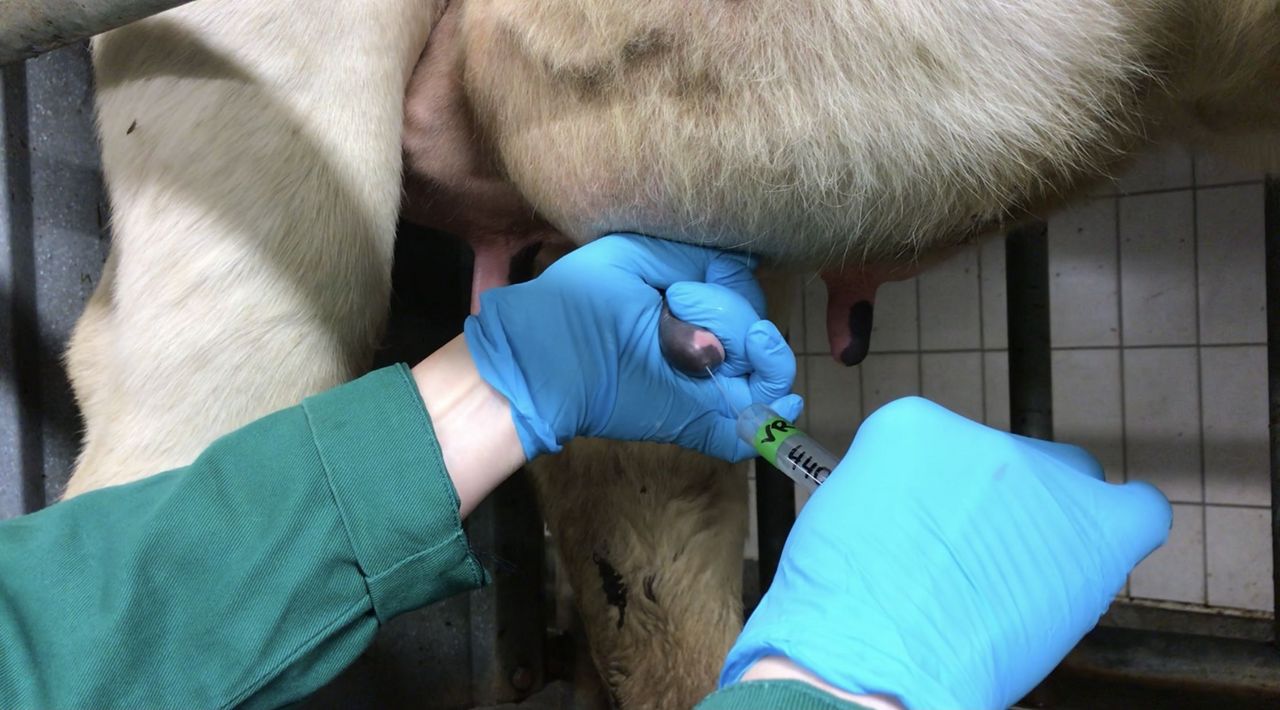Project
MinimA - Quarter selective dry off in dairy cows

MinimA - Sustainable minimization of antibiotic drug use due to quarter-selective dry off in dairy cows
Maintaining the therapeutic efficiency of antibiotics in human and veterinary medicine requires their strictly demand-oriented use. In our project, we apply this principle to the dry off treatment of dairy cows on farms.
Background and Objective
Maintaining the therapeutic efficiency of antibiotics in human and veterinary medicine requires their strictly demand-oriented use. In dairy production, antibiotics are used at dry off to cure mastitis and prevent new infections. The scientific aim of the project is to test a dry off treatment under practical conditions that is consistently oriented towards the detection of udder pathogens in order to reduce the use of antibiotics to a minimum without adversely affecting animal health. It will be tested if the observations that were made at the two experimental stations are confirmed under farm conditions. In particular, we aim to answer the following questions:
- Can the quarter selective dry off treatment be recommended without increasing the risk of new infections in udders of cows that had only one or two infected quarters before drying off?
- Do herd effects influence the success of the dry off method? Can these effects be described and is their impact quantifiable?
- To what extent is the application of antibiotic drugs reducible?
- Is the procedure suitable under practical conditions? Which error sources and restraints have to be taken into account if the method should be recommended to many dairy farms?
Approach
Decision trees that select the animals to be treated on the base of milk recordings combined with a cowside test are increasingly used, but often base on inflammation parameters rather than on the detection of pathogens. MinimA follows a different approach that is consistently oriented towards detection of pathogens: only infected udder quarters of the cow are dried off under antibiotic protection. All other quarters receive only an internal teat sealer to prevent new infections. This approach has already been successfully tested on experimental farms and is now being tested for its suitability in practice. This is done in a network of dairy farms in coordination with the farm veterinarians. After clarifying the infection status of the herds, the farms dry off the quarters of their cows according to the results of bacteriological sample analysis. Treatment success is checked after calving. In workshops, which follow the stable school principle, the project farms exchange information about the procedure, and directly report back their experiences and suggestions in feedback discussions with the scientists. At the end of the project a freely accessible guideline will be developed based on this mutual knowledge transfer and the experiment’s results. The guideline should enable other dairy farms to apply the method to their own cows.
Data and Methods
Quarter fore-milk samples will be collected from 75 cows of every farm participating in the project. The first sample is taken two weeks prior to drying off and the second sample three to five days after calving. All samples will be analysed at the MRI on somatic cell count and mastitis pathogens. Depending on the outcome of the bacteriological analyses before drying off, the udder quarter will be treated with an antibiotic drug and an internal teat sealer or only an internal teat sealer will be used. Control of the bacteriological cure rate will be based on the sample that will be taken after the calving.
Results
A total of 16 German dairy farms tested the quarter-selective approach over two years. The results showed a substantial potential for antibiotic savings: Out of 1,155 dry periods from 1,126 cows, 91.9% of the udder quarters were dried off without antibiotic treatment. On average, only 8.1% of the quarters (2.6% – 28.8% depending on the farm) received antibiotics at dry-off. Compared to the farms’ previous selective dry cow strategies, the quarter-level approach resulted in an additional antibiotic savings potential of 80.8%. Despite the reduced use of antibiotics, a high average cure rate of 97.1% for antibiotic-treated quarters (86.2% – 100.0% depending on the pathogen) was achieved. High self-cure rates of minor pathogens (non-aureus staphylococci and Corynebacterium spp.) above 80% indicate that antibiotic treatment is not necessarily required at dry-off.
For practical implementation, the following are important: consultation with the veterinarian, good level of management, motivated farm and herd managers, as well as correct and clean collection of quarter fore-milk samples, in order to obtain bacteriological results before scheduled dry-off date. Designating a specific day of the week for both sampling and dry-off seemed to be useful. In addition, assigning these tasks to a few responsible people was practiced on many project farms.
In general, regular sampling prior to dry-off provides continuous information on the mastitis pathogens prevalent on the farm. This information can be used to improve and sustain udder health.
The project results showed that it is possible to implement a quarter-selective dry cow therapy based on bacteriological outcomes in commercial dairy farms. The approach resulted in a substantial antibiotic savings potential without compromising udder health.
- MinimA - Flyer (in German)
- Fact Sheet: Quarter selective dry off in dairy cows (in German)
- Procedures for collecting quarter-fore milk samples (in German)
- Procedure of using a teat-sealer (in German)
- Quickguide to use a teat-sealer and an antibiotic dry-off-treatment (in German)
- Quickguide to use a teat-sealer (in German)
- Checklist: Can I dry-off my herd quarter-selectively? (in German)
Thünen-Contact

Involved Thünen-Partners
Involved external Thünen-Partners
- Max Rubner-Institut, Bundesforschungsinstitut für Ernährung und Lebensmittel (MRI)
(Karlsruhe, Hamburg, Deutschland)
Funding Body
-
Federal Ministry of Food und Agriculture (BMEL)
(national, öffentlich)
MinimA is a Model- and Demonstration Project for animal welfare and financially supported by the Federal Ministry of Food and Agriculture based on a decision of the Parliament of the Federal Republic of Germany, granted by the Federal Office for Agriculture and Food.
Duration
9.2020 - 12.2023
More Information
Project funding number: 2819MDT211
Project status:
finished
Publications
- 0
Beckmann A, Barth K, Knappstein K (2024) Vom kuh- zum viertelselektiven Trockenstellen: Antibiotika-Einsparpotential in deutschen Praxisbetrieben. In: Tagung der DVG-Arbeitsgruppe Eutergesundheit : Leitthema: Eutergesundheit 2024 - Mythen, Daten, Fakten ; 18.-19.03.2024, AG Eutergesundheit, Schwäbisch Gmünd. Gießen: Verlag der DVG, pp 43-48
- 1
Knappstein K, Beckmann A, Barth K (2023) Chancen des viertelselektiven Trockenstellens zur Reduktion des Antibiotikaeinsatzes in Milchviehbetrieben. In: 63. Arbeitstagung des Arbeitsgebietes Lebensmittelsicherheit und Verbraucherschutz, 26.-29.09.2023, Garmisch-Partenkirchen/ online. Gießen: Verlag der DVG, pp 67-69
- 2
Beckmann A, Barth K, Knappstein K (2023) Quarter-selective dry-off can reduce the use of antibiotics without putting the udder health at risk. In: Deutsche Veterinärmedizinische Gesellschaft (ed) European Buiatrics Congress and ECBHM Jubilee Symposium, Berlin, Germany, August 24-26, 2023 : Abstract-book. Gießen: Verlag der DVG, pp 226-227
- 3
Beckmann A, Barth K, Knappstein K (2023) Unbedingt zu beachten: Neuinfektionen zwischen Trockenstellen und Kalbung. In: Tagung der DVG-Fachgruppe "Umwelt- und Tierhygiene", 05.-06.10.2023, UTH, Kiel. Gießen: Verlag der DVG, pp 19-20
- 4
Beckmann A, Barth K, Knappstein K (2023) Viertelselektives Trockenstellen - ein Ansatz zur nachhaltigen Reduktion des Antibiotikaeinsatzes. In: Bibic V, Schmidtke K (eds) One step ahead - einen Schritt voraus! : Beiträge zur 16. Wissenschaftstagung Ökologischer Landbau, 07.-10. März 2023, Frick (CH), FiBL Campus. 1. Auflage. Berlin: Verlag Dr Köster, pp 558-561
- 5
Beckmann A, Knappstein K, Barth K (2023) Viertelselektives Trockenstellen : Antibiotikaeinsatz nachhaltig reduzieren ; Empfehlungen aus der Wissenschaft und Erfahrungen aus der Praxis ; Ratgeber. Trenthorst: Thünen-Institut für Ökologischen Landbau, 48 p, DOI:10.3220/MX1689668102000
- 6
Knappstein K, Beckmann A, Barth K (2022) Herausforderungen bei der praktischen Umsetzung des viertelselektiven Trockenstellens im Projekt "MinimA". In: Kühe - Klima -Käsespätzle : Gegenwärtige Herausforderungen für Eutergesundheit und Milchqualität ; 14. bis 15. März 2022, Online-Tagung. 1. Aufl. Gießen: DVG Service GmbH, pp 145-151
- 7
Beckmann A, Barth K, Knappstein K (2022) Prävalenz von Mastitiserregern in Milchviehbetrieben mit Interesse am viertelselektiven Trockenstellen (Projekt MinimA). In: Kühe - Klima -Käsespätzle : Gegenwärtige Herausforderungen für Eutergesundheit und Milchqualität ; 14. bis 15. März 2022, Online-Tagung. 1. Aufl. Gießen: DVG Service GmbH, pp 45-56
- 8
Beckmann A, Knappstein K, Barth K (2022) Viertelselektives Trockenstellen - was ist zu beachten und was kann ich erwarten? In: Tagungsband 22. Jahrestagung der WGM 4.-6. Oktober 2022 an der Bayerischen Landesanstalt für Landwirtschaft (LfL) in Grub. Iden: Wissenschaftliche Gesellschaft der Milcherzeugerberater, pp 53-58
- 9
Barth K, Knappstein K (2021) Nur ein Euterviertel antibiotisch trockenstellen? Top Agrar 50(6):R16-R19

![[Translate to English:] [Translate to English:]](/media/_processed_/8/e/csm_Bildschirmfoto_2021-03-03_bearb_fc48ac88bf.jpeg)
![[Translate to English:] [Translate to English:]](/media/_processed_/8/e/csm_Bildschirmfoto_2021-03-03_bearb_ba3ec0e9d7.jpeg)
![[Translate to English:] Logo des Bundesministerium für Ernährung und Landwirtschaft](/media/allgemein/logos/BMEL_Logo.svg)